It’s big, it’s unique, and it’s the focal point of recreational interaction with the sea for one of the more affluent areas of population in Europe writes W M Nixon. But anyone visiting Dun Laoghaire Harbour for the first time, someone who knows something of sailing’s complex organisation afloat and ashore in other major sailing centres, might well wonder how a place with so many potentially conflicting demands and interests can manage to run a harmonious, successful and multi-faceted weekly sailing programme year after year.
The answer is Dublin Bay Sailing Club, which is the net that holds it all together despite the Harbour having four different waterfront clubs, each of which takes great satisfaction in its distinctive history, with the oldest dating back to 1831. These clubs in turn have their four clubhouses, and histories that they can proudly call their own, independently of the three neighbouring clubs. And the pride the members take in the club and clubhouse to which they give their first loyalty is indicated by the unmistakable initials – or sometimes even the full name – of the specific club on the transom of their boat, and through club insignias on their own clothing.
With such devotion, you might expect that each club would want to run its own complete annual sailing programme. Certainly each club runs its own Junior Training Programme, and matching Adult Introductory Courses. And every other year, when the biennial four–day Volvo Dun Laoghaire Regatta is not being staged, each club will put on its own regatta, with flags flying, music playing, and traditional hospitality – strawberries and cream, the lot - being laid on for fellow sailors, mostly from the other clubs in Dun Laoghaire, but also from clubs north and south of Dublin Bay.
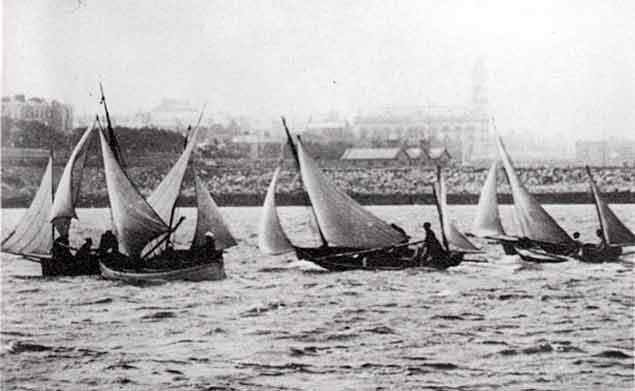 Dublin Bay Sailing Club racing in the 1880s. Originally formed in 1884 to cater for small boats, the Club has evolved into today’s umbrella organization to organize the weekly programme for all Dun Laoghaire’s racing boats, and it thus caters for the waterborne sport of thousands of enthusiasts. Photo courtesy NYC.
Dublin Bay Sailing Club racing in the 1880s. Originally formed in 1884 to cater for small boats, the Club has evolved into today’s umbrella organization to organize the weekly programme for all Dun Laoghaire’s racing boats, and it thus caters for the waterborne sport of thousands of enthusiasts. Photo courtesy NYC.
Yet despite the potential for rampant individuality, thanks to the existence of Dublin Bay Sailing Club as an umbrella body to which everyone gives an extra layer of loyalty, the regular shared sailing programme is smoothly structured. And the publication of the DBSC 2018 Yearbook gives us an unrivalled overview of an exceptionally effective organization which is right up to the minute in its preparation for the new season, yet has a history going back to 1884.
The diligent listing of every boat which races within its ambit, and the class with which they race (there are 21 different classes in all) provides us with a preview of potential winners. That said, the future inclusion of some hot new boats as yet un-named could add a frisson of extra interest, but the DBSC machine runs so smoothly that they can accommodate these additions at the appropriate time.
And it’s also true the different classes vary enormously in their numbers. The stately craft in Cruiser 0 muster just five boats, and once again George Sisk’s successful Farr 42 WOW is listed as entered, after setting the pace in 2017. But so too is Paul O’Higgins’ high-rated (in ECHO terms) JPK 10.80 Rockabill VI. Yet we know already that Rockabill VI is entered for the Volvo Round Ireland Race with the significant presence of Mark Mansfield on board, so that will take pressure off WOW for a week or two in the continuing Dun Laoghaire programme.
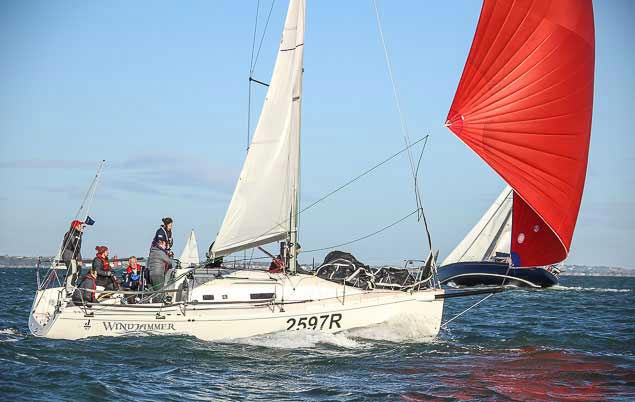 The J/109 Windjammer (Lindsay Casey and Denis Power) won the Dun Laoghaire Harbour Company Trophy for Best Newcomer in 2017. Photo: Afloat.ie
The J/109 Windjammer (Lindsay Casey and Denis Power) won the Dun Laoghaire Harbour Company Trophy for Best Newcomer in 2017. Photo: Afloat.ie
By contrast, Cruisers 1 musters 22 boats, thanks in large measure to some of Dun Laoghaire’s substantial J/109 fleet being included. 2017 saw Tim & Richard Goodbody’s J/109 White Mischief as Cruisers I Champion, while another J/109, Lindsay Casey & Denis Power’s Windjammer, won the Dun Laoghaire Harbour Trophy for best newcomer in 2017. But under the cruiser classes division lines, she races in Cruisers 2, where they now number 24 boats thanks to the inclusion of the formerly One Design Sigma 33 Class, where Rupert (Dick & Philip Lovegrove) was best boat in 2017.
The biggest One-Design Keelboat Class is the Flying Fifteens with 29 boats, and last year they provided the winner of the top One Design to take the George Arthur Newsom Cup with Ben Mulligan on As Good As It Gets, surely the favourite going into the season of 2018.
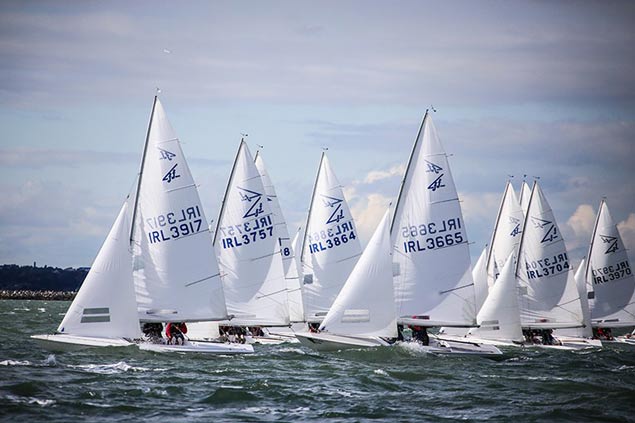 The Flying Fifteens are the numerically largest One-Design keelboat class in Dublin Bay, and one of the largest in the DBSC programme in all categories
The Flying Fifteens are the numerically largest One-Design keelboat class in Dublin Bay, and one of the largest in the DBSC programme in all categories
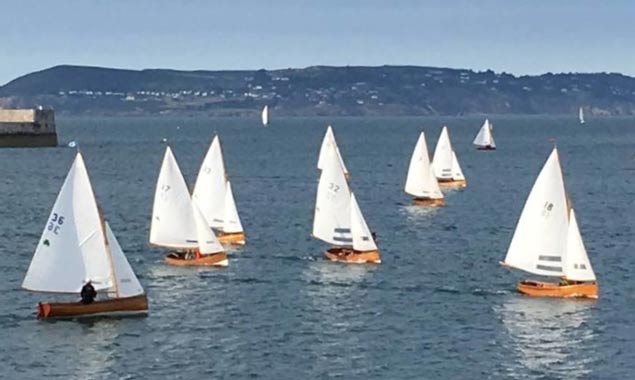 “Age shall not wither them….” Despite their origins back in the 1880s, the Water Wags still see new boats being built, and they are now the largest class listed in the DBSC Yearbook 2018. Photo courtesy Water Wags.
“Age shall not wither them….” Despite their origins back in the 1880s, the Water Wags still see new boats being built, and they are now the largest class listed in the DBSC Yearbook 2018. Photo courtesy Water Wags.
However, the well-supported Flying Fifteens are out-stripped numerically by the Lasers, of which 30 are listed as expecting to race regularly during 2018. But the Lasers in turn are out-numbered by the most senior class of all, the Water Wags, that classic dinghy class which has its origins in 1887, though today they race a design which the class introduced in 1900.
You might well think that such cherished classics are only occasionally used, but in fact the Water Wags provide robust racing, and on their final evening race of the 2017 season, they honoured the Water Wag Class Presidency of yachting historian Hal Sisk by mustering a record turnout of 31 boats out of 32 known to exist. That was showing it to the newer classes, and no mistake. And winners on that evening were David and Sally MacFarlane with the 107-year-old Mousmie.
Technically speaking, there’s no greater contrast that that between the traditional Water Wags and the lift-keel sportsboats of the SB20 class which have 18 boat entered for 2018’s racing, and they include Michael O’Connor’s super-successful Sin Bin which had a stellar season last year, winning both the Corinthian World title in the Solent, and the Irish Nationals at Howth.
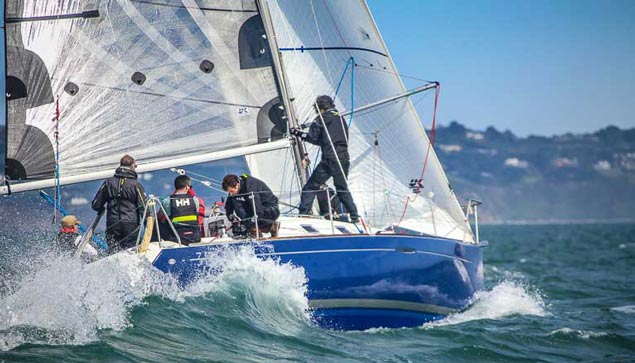 Chris Johnston’s Prospect, one of the top performers in the well-supported First 31.7 Class. Photo: Afloat.ie
Chris Johnston’s Prospect, one of the top performers in the well-supported First 31.7 Class. Photo: Afloat.ie
As for the numerically biggest Cruiser One-Design Class, that’s the First 31.7 with 15 boats, with Chris Johnston’s Prospect winning the Feanor Trophy for the Thursday series, which is the heart of the cruiser classes weekly racing.
However, such is the long and active history of Dublin Bay SC over 134 years, morphing from a club to provide racing for small boats into the umbrella organization looking after the entire Dun Laoghaire racing fleet, that they now have so many trophies that the Annual Prize-Giving in November is a real “Shift the Silverware” business which has to be skilfully choreographed. But here again the club’s experience and its deep pool and willing and able volunteers – they’ve something like 90 active voluntary workers afloat and ashore – keep things running smoothly.
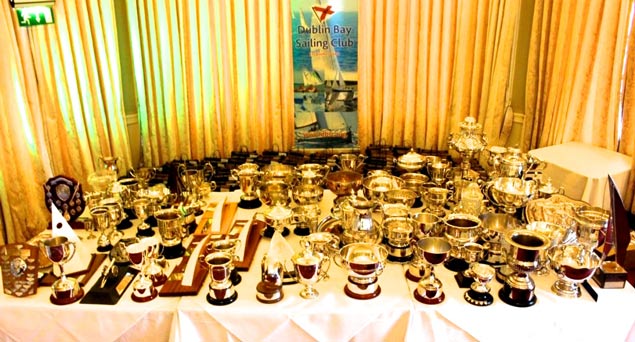 “Shifting the silverware” – the array of trophies at DBSC’s annual prizegiving includes many of incalculable historical value.
“Shifting the silverware” – the array of trophies at DBSC’s annual prizegiving includes many of incalculable historical value.
Despite not having the maintenance of a clubhouse to take up time and energy, Dublin Bay Sailing Club has to devote resources to the upkeep of its two purpose-built committee boats, the catamarans Mac Lir and Freebird. They also have a shoreside Race Officers hut at the end of the West Pier that had been “brought in” for the winter - good thinking, as Storm Emma did real damage down there, and the DBSC Starters Hut, scene of much inter-volunteer banter amidst the hard work of race records maintenance, would have been swept clean away.
 Mac Lir is one of the two catamaran committee boats needed by DBSC to keep its complex programme in operation.
Mac Lir is one of the two catamaran committee boats needed by DBSC to keep its complex programme in operation.
With so many boats and classes involved, each class is expected to have its own formally-appointed Record Keeper, which is something that could be usefully copied across the entire sailing scene. Anyone who has ever tried to write a history of a yacht or sailing club will soon learn that the only obligation of past generations has been to maintain the minutes of the General Committee and the Annual General Meetings. Actual sailing records are often very sparse, so DBSC is like a breath of fresh air in having this requirement of its constituent classes.
But although class record keepers may change from year to year, ultimately the continuing viability of any club will depend on the long-term presence of key voluntary workers, and in Dublin Bay SC they have this extraordinary corps of at least 90 people who regularly give unstintingly of their own time to facilitate the sailing of others.
Queen of them all in DBSC is Carmel Winkelmann, who was recently very properly honoured at the annual Irish Sailing Awards by a special Presidential Award from Irish Sailing President Jack Roy, who is himself not slow in stepping up to the plate when volunteers are needed – he has officiated as Race Officer at major events at home and abroad, but every Thursday Jack Roy is out there on the bay, Senior Race Officer with Dublin Bay SC at the biggest evening racing turnout in their busy weekly programme.
The way in which such effective volunteers are selected is sometimes one of the great mysteries, but in Dublin Bay Sailing Club’s case a significant factor is the presence of long-time Honorary Secretary Donal O’Sullivan, whose wisdom in spotting useful administrative talent is a legend in Irish sailing.
 The Keeper of the Flame. Donal O’Sullivan, long-time Honorary Secretary of Dublin Bay SC. “His wisdom in spotting useful administrative talent is a legend in Irish sailing”.
The Keeper of the Flame. Donal O’Sullivan, long-time Honorary Secretary of Dublin Bay SC. “His wisdom in spotting useful administrative talent is a legend in Irish sailing”.
Meticulous himself in his maintenance of all that is needed in running such a complex club, he has a sixth sense of who would be useful to bring into the tent, and it was he who ensured that Chris Moore is the current DBSC Commodore.
Chris Moore’s rise to prominence in sailing has by no means been by the establishment routes you might expect. Although a Dun Laoghaire boy (he has lived in the same house in Glenageary for 48 years) he was from a non-sailing family. The Boy Scouts were his main interest, such that by his early 30s (having taken a Marketing Degree in Rathmines and started a career in medical supplies) he was the Scouts Commissioner for Dun Laoghaire, with 18 troops under his oversight.
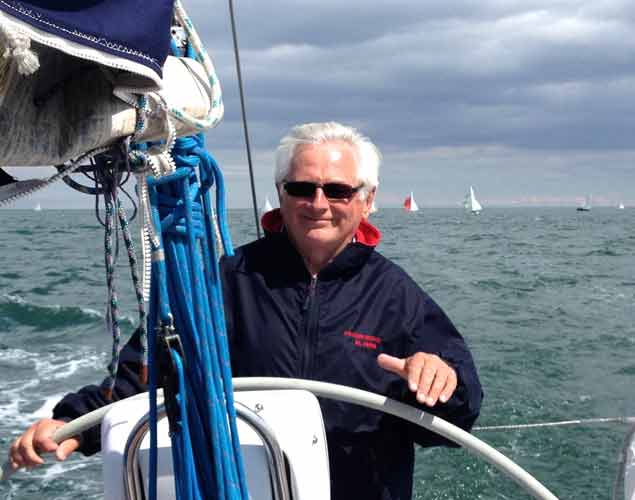 Chris Moore. When he retires as DBSC Commodore in November, he will have completed a total of 27 years in executive flag officer roles - first at Bray Sailing Club, then at the National Yacht Club, and currently at Dublin Bay Sailing Club
Chris Moore. When he retires as DBSC Commodore in November, he will have completed a total of 27 years in executive flag officer roles - first at Bray Sailing Club, then at the National Yacht Club, and currently at Dublin Bay Sailing Club
However, another Scout administrator, Bruce Carswell, had taken him for a sail in Dun Laoghaire Harbour, and he was sufficiently interested to acquire a Mirror Dinghy to keep at the family summer home at Kilbegnet near Arklow. But his efforts to teach himself to sail this little boat in Dun Laoghaire were such that when his wife Sandra noted that Bray Sailing Club were offering Adult Learning Courses, she determinedly persuaded him to sign up, and Bray provided the base for the proper start of his sailing career.
It soon also provided the beginning of his of long experience of sailing administration. People see Chris Moore as both a safe pair of hands and as a diplomat and persuader who gives unstintingly of himself, knowing when to retrench but equally knowing when to start the grand projects. Thus he was recruited into the administrative stream in Bray SC, and served for four years as Commodore.
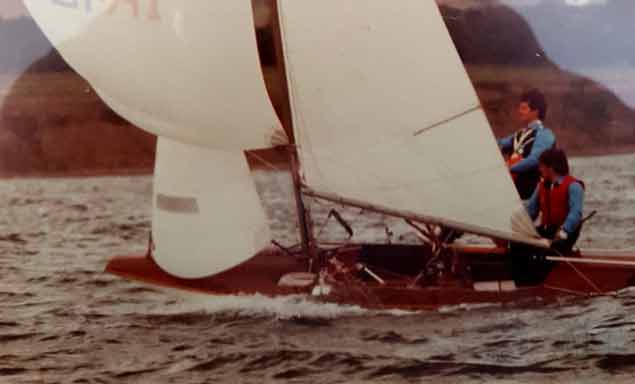 A first taste of real performance sailing – Chris Moore racing the Fireball Artful Dodger, which he bought from Roger Bannon
A first taste of real performance sailing – Chris Moore racing the Fireball Artful Dodger, which he bought from Roger Bannon
 The first foray into keelboat racing with the Ruffian 23 QB2 and sailing from the National YC. Much of Chris Moore’s Ruffian 23 campaigning was done in partnership with David Fenton.
The first foray into keelboat racing with the Ruffian 23 QB2 and sailing from the National YC. Much of Chris Moore’s Ruffian 23 campaigning was done in partnership with David Fenton.
But his own sailing was also developing with all the zeal of the convert, and he progressed it with several boats, both cruisers and dinghies. He has particularly fond memories of two Fireballs which had both been immaculately finished from Plycraft hulls by Roger Bannon, but as he then moved on towards Ruffian 23 racing in Dun Laoghaire, this confirmed his involvement with the National Yacht Club which he joined in 1989.
There, his favourable reputation was such that he was recruited as Rear Commodore without even having served on the Committee. By the time he retired as NYC Commodore in 2005, he’d left his imprint on the club, for he firmly believed that in an active sailing club the changing rooms are the most important facilities in the place, and his upgrading of the changing rooms in the NYC set a new standard for Ireland.
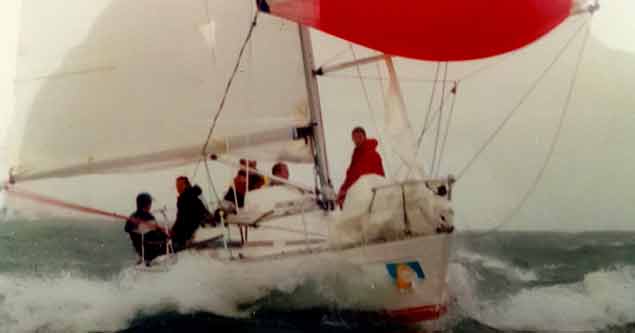 The Sigma 33 Powder Monkey
The Sigma 33 Powder Monkey
By 2005 he had developed his sailing career through two Ruffian 23s and then into the Sigma 33s with a “sort of” syndicate, but he had equally spent much of his spare time in club administration. However, his time of voluntary work was by no means over, for the eagle eye of Donal O’Sullivan had recorded Chris Moore’s possibility availability for DBSC, and so began another lengthy period in harness, this time continuing until the Dublin Bay SC AGM in November this year when he finally steps down from the top post after serving his time through all the DBSC Commodore roles.
At the age of 73, his zest in sailing remains undiminished – the current boat is the J/109 Powder Monkey with which they were pioneers of J/109 racing in Dublin Bay more than dozen years ago.
And his willingness to buckle down when a bit of hands-on work is required is renowned. When I made the first phone call to set up the necessary conversations and memory trawling which this piece needed, it was to find that the Commodore DBSC was in the depths of the club’s Committee Boat Mac Lir, clearing out surplus items for a proper re-commissioning of this important vessel.
In all, he removed two marina barrows of what the rest of us might call detritus. Then when next we talked, he’d been clarifying his thinking on being Commodore in organisations as diverse as Dublin Bay SC, the National YC, and Bray Sailing Club. All of it was pure gold, and quietly entertaining with it. If he’s not careful, some time after November he’ll find himself being recruited on the motivational speaker circuit………Meanwhile, he will continue beyond November in another of his roles – he’s the long-serving Round Ireland Speed Record Commissioner.
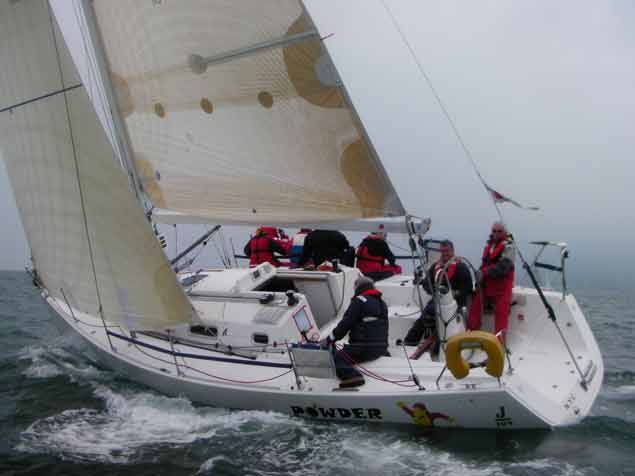 Chris Moore and his friends racing the J/109 Powder Monkey. Photo: Maurice O’Connell
Chris Moore and his friends racing the J/109 Powder Monkey. Photo: Maurice O’Connell
































































